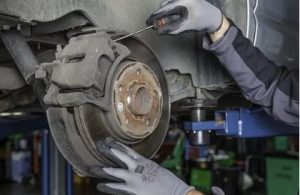When the snow hits the West Islip, New York, area, the driving conditions can become treacherous. However, modern cars are getting more sophisticated all the time with safety systems that help you out when the going gets tough. An anti-lock braking system (ABS) has become an essential standard feature on all new cars. Here, we have a look at how your ABS works to keep you safe in snowy or icy conditions. 
How Does ABS Work?
When you have to stop in an emergency, ABS enables you to apply maximum pressure on the brake pedal without any of the wheels locking up and possibly putting you into an uncontrollable skid. Before ABS, drivers were advised to use cadence braking which involves pumping the brake pedal rapidly to prevent skidding.
Computer-controlled ABS imitates cadence braking, but much more efficiently. Speed sensors at each wheel measure the rate of spin and the controller applies and releases the brakes in fractions of a second to bring you to a safe stop without the driver needing to pump the brake pedal.
Peace of Mind When You Need It
If you’ve ever been in the situation where your wheels have locked up on an icy road, you have experienced that moment of panic when you realize that you’re not in control. When your wheels lock up, you also lose the ability to steer effectively as you need traction for that. It isn’t unheard of for drivers to go straight through an intersection with catastrophic results.
ABS allows you to bring the car to a controlled stop in the shortest possible distance. If you’re braking to avoid an obstacle or animal, you can apply the maximum pressure to the brakes and give your full concentration to steering around the obstacle.
ABS Isn’t Always the Best
Many modern cars allow you to turn off the ABS and you might wonder that, if it’s so good, why would you want to disable it? When you’re driving in deep fresh snow, your own driving skills can help you to stop more quickly than the ABS.
When driving on a loose surface, braking gently and modulating the pressure on the pedal brings you to a safe stop in a shorter distance than mashing the pedal and relying on the ABS. In addition, if the wheels do lock, the buildup of snow under the tires has a braking effect.
Get to Know How Your Car Reacts
Many new cars have standard driver assistance features for handling and braking such as Toyota’s Star Safety System, which includes enhanced vehicle stability control, traction control, ABS, electronic brake force distribution, brake assist, and smart stop technology.
If you’re not used to driving in snow, the best way to familiarize yourself with these systems and how your car reacts is to find a deserted snowy area, like a parking lot. Attempt to drive into a skid, and experiment with braking and turning.
Whenever you have to drive in bad weather conditions, allow more time for your journey and drive cautiously. If you want to know more about Toyota’s safety systems, contact Atlantic Toyota.



